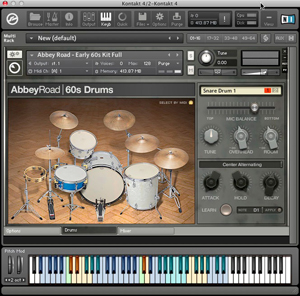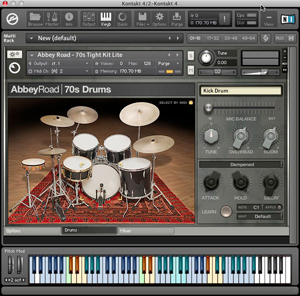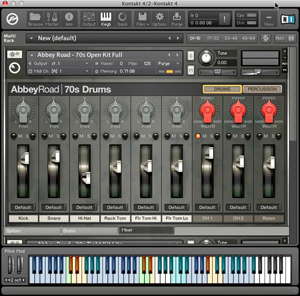Review: Native Instruments Abbey Road 60s and 70s Drums
While over the years we have seen endless variations of the “Super Mondo Hyper Every Drum Ever!” sound libraries that sometimes valiantly, but often lamely, attempt to cover your every drum and percussion need, I appreciate the trend that’s moving in the opposite direction.
Sonic Reality’s Ocean Way Drums may have lead the charge toward meticulously recording a limited amount of acoustic kits with the some of the finest gear in the best facilities, and now Native Instruments (NI) is taking up the banner with its Abbey Road 60s and 70s Drums collections ($119 each).
Both 6+ GB collections feature only a couple of different vintage drum kits recorded in Abbey Road’s Studio Two using top gear from their respective eras. Within the free Kontakt 4 Player (or full Kontakt 4) interface, you get ample control over the individual sounds, as well as mixing for the various microphone positions on hand. Easy integration with a DAW through the Kontakt 4 plug-in, as well as various MIDI mappings for electronic drum kits and drum software, make these libraries a classic experience with all the modern conveniences.
BOOKING TIME
These libraries’ installers wouldn’t let me initially install them to my external hard drive, unfortunately, which turned out to be a time waster. I had to first install the libraries to the internal drive, then transfer them to my external sound library drive, direct the Kontakt 4 software to that external drive in its Preferences, and finally delete the originally installed libraries.
Also, as with all Native Instruments software, you have to work with its Service Center utility to authorize programs. Here I decided, just to be safe, to upgrade from Kontakt 4.0.4 to 4.0.5. That turned out to be a 600+MB download to get file updates that add a scant 40KB to my hard drive. Perhaps all the was necessary, but it struck me as inefficient.
With everything up and running, it was very simple to load Kontakt 4 as a plug-in instrument on a DAW track and call up one of the Abbey Road kits, whereby I easily used the MIDI keyboard or pad controller of my choice to commence to rocking. Kontakt 4’s handy color-coded keyboard shows the layout of each drum kit preset, so you can familiarize yourself with playing them on keys.
DREAM GEAR
Abbey Road 70s Drums was recorded on an EMI console to 2-inch Ampex tape using Neumann, AKG and Beyerdynamic mics. There are only five Kontakt instruments you can load in the collection, and all of them derive from just two acoustic kits.
The “Open Kit” comes from a 1972 Ludwig Vistalite kit, with 26″ kick, three toms, two snare options, hi-hat and four cymbals. The largest instrument setting from this collection, “70s Open Kit Full,” requires a whopping 710 MB of memory and gives you 11 instrument mic and 3 room mic positions. Four Mic (368 MB) and Lite (242 MB) versions of this instrument reduce the memory load significantly.
The Open Kit was recorded with a big, roomy sound (think Zeppelin), while the Tight Kit was recorded for a punchier, dry sound. For the Tight Kit, NI used a 1970’s Premier kit with smaller kick and toms and the same number of snare and cymbal options. Again, a Full (510 MB) and Lite (171 MB) version of this kit is available.
For Abbey Road 60s Drums, NI turned to a 1958 Redd.17 valve mixing desk, 1967 EMI desk, 1964 Studer 1-inch tape machine and mics from Neumann, AKG, Sony and STC. Two kits were employed.
For the three “Early 60s” instrument settings, a Gretsch White Marine Pearl handled duties, and for the three “Late 60s” instruments, it was a 1967 Ludwig Hollywood. Both kits include two snare options each, which come from vintage Ludwig and Slingerland models. Each of the 60s and 70s kits also include 3-5 percussion sounds per kit, with sounds such as tambourine, clap, sticks, cowbell, shaker and rototom.
MIKED AND MIXED
Within the Kontakt 4 interface, both Abbey Road collections utilize the same control scheme, consisting chiefly of three tabbed pages: Drums, Mixer and Options. On the Drums page, you see the kit, with each drum highlighted as you play it.
For each sound in the kit, you can alter the tune, attack, hold and decay of the sound, as well as the amount of overhead and room mic you want mixed in for that sound. In addition, the kick and snare have a Mic Balance slider to adjust the balance between of the two mic positions used for those drums.
Over on the Mixer page, you have simple mixer channels for each of the drum and percussion instrument mics and the overhead/room mics used. For each channel, you have Pan/Width settings, pan and solo buttons and volume faders. The Options page give you control over Snare Mic Bleed, the velocity settings and a novel Randomize section. Turn on Randomize to introduce random variations over a number of playing attributes if you want to add a “human” element to drum loops. You can control the amount of volume, velocity, time, pitch and EQ variations in the Randomize section.
NOW… CAN YOU PLAY?
When you consider the scope of NI’s Abbey Road drums project — the recording equipment, gear and the studio itself that most of will never have access to — and the resulting collections, it’s hard to conclude anything else than kids these days (of all ages) are spoiled. Both collections amass more than 29,000 24-bit/44.1 kHz samples in order to give you up to 30 (AR60s) or 34 (AR70s) velocity layers per drum. The recordings sound amazing and authentic (listen to demos for yourself below), and when I think about how easy it is to start making drum tracks quickly with Kontakt’s various MIDI mappings, it’s like I’m being rewarded for all the past suffering trying to get sampled drums to work properly.
I’m not about to say that these are the best sounding acoustic drum collections in the world. Such a claim is neither possible nor necessary to make. But at $119 each, these are very reasonably priced for what you get. And because these are very focused, specific drum libraries, the main question here is were they executed well? Without a doubt they were. Do you want detailed, thoroughly recorded and authentic-sounding 60’s or 70’s drums without going through the old-school hassles and expense of getting them? If so, well then… here you go. No thanks necessary. — Markkus Rovito
ABBEY ROAD 60s & 70s DRUM DEMOS
Please note: When you buy products through links on this page, we may earn an affiliate commission.









